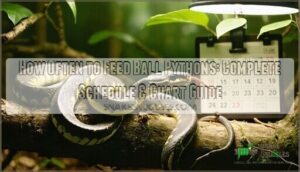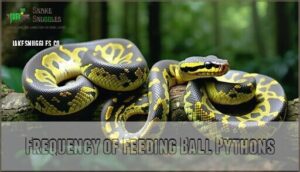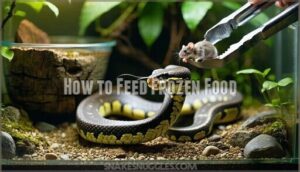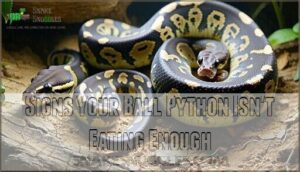This site is supported by our readers. We may earn a commission, at no cost to you, if you purchase through links.

Think of it like setting a biological alarm clock – younger snakes burn energy faster and need frequent refueling for growth, but mature pythons slow down their metabolism substantially.
Your snake’s age determines everything: hatchlings under six months eat weekly, sub-adults get fed every 7-10 days, and full-grown adults can wait two weeks between meals.
Don’t worry if your python skips a meal occasionally – they’re notorious for being picky eaters. Getting the timing wrong affects their health more than you’d expect, and understanding this can help you provide better care for your python’s health.
Table Of Contents
- Key Takeaways
- How Often to Feed Ball Pythons?
- Frequency of Feeding Ball Pythons
- Optimal Prey Size for Ball Pythons
- Supplements for Ball Pythons
- Feeding Schedules for Different Age Groups
- Signs Your Ball Python Isn’t Eating Enough
- How Long Can Ball Pythons Go Without Eating?
- Avoiding Overfeeding Your Ball Python
- Frequently Asked Questions (FAQs)
- Can you leave a heat lamp on 24/7 for ball python?
- How much should I feed my ball python?
- How do I know if my ball python is eating enough?
- How long can ball pythons go without eating?
- Can you overfeed a ball python?
- What type of prey should be avoided?
- How should frozen prey be thawed safely?
- What are the best feeding tools to use?
- Why should wild-caught prey be avoided?
- When is the best time to feed a ball python?
- Conclusion
Key Takeaways
- Feed young pythons more frequently – You’ll need to feed juveniles every 5-7 days since they’re growing rapidly and burning energy fast, while adults only need meals every 10-14 days due to their slower metabolism.
- Choose prey that’s the right size – Your prey should match your snake’s thickest body section in width and weigh 10-15% of your python’s total body weight to ensure safe digestion and proper nutrition.
- Don’t panic if they skip meals – Ball pythons are notorious picky eaters and can safely go months without food, especially during shedding periods or seasonal changes when fasting is completely normal behavior.
- Stick to frozen-thawed prey for safety – You’ll avoid injury risks from live prey bites while ensuring your snake gets proper nutrition – just warm the prey to 100-105°F before feeding to make it appealing.
How Often to Feed Ball Pythons?
Your ball python feeding schedule depends on age and size. Hatchlings need meals every 5-7 days, while adults can wait 2-4 weeks between feedings. Individual variation matters – some snakes have faster metabolisms than others.
Ideal intervals allow proper digestion time between meals. Young pythons under 500 grams should eat weekly. Adults over 1,500 grams typically eat every 14-21 days. Activity levels also influence feeding frequency – more active snakes may need food sooner.
Frozen-thawed prey is generally considered nutritionally complete for ball pythons. Skip feeding during shedding fasting periods when your snake’s eyes turn milky.
Their python feeding schedule becomes less frequent as they mature. Monitor your snake’s body condition to adjust the how often feed routine. Consistency in your ball python diet schedule helps maintain peak health.
Frequency of Feeding Ball Pythons
Getting your ball python feeding schedule right is like finding the perfect rhythm for a dance. Your snake’s age determines how often you’ll need to feed them.
Finding the perfect feeding rhythm is like dancing with your snake’s natural hunger cycle.
Hatchlings need meals every 5-7 days because they’re growing fast and burning energy quickly. Think of them as teenagers who can eat everything in your fridge.
Juveniles do well with feeding every 7-14 days as their growth rate starts slowing down.
Adult ball pythons only need food every 10-14 days, while mature adults can go 21-50 days between meals. Their metabolism slows dramatically with age, so they don’t need constant fuel.
Weight monitoring helps you nail the perfect feeding frequency. Skip meals during shedding since stressed snakes often refuse food anyway.
Digestion time varies, but most pythons need several days to process their meal completely. Adjusting frequency based on your snake’s body condition keeps them healthy and happy.
Optimal Prey Size for Ball Pythons
Choosing the right prey size keeps your ball python healthy and stress-free.
The golden rule is simple: prey width should match your snake’s thickest point.
A proper Post-Feeding Bulge shows you’ve nailed the size—visible but not excessive.
Your Prey Weight Ratio should be 10-15% of your snake’s body weight.
Young pythons start with mice, while adults graduate to appropriately sized rats.
When your snake’s Girth vs. Size changes with age, adjust accordingly.
Multiple Prey Items aren’t necessary if you choose the right food size.
Ball pythons, also known as Python regius, are native to West Africa.
- Maximum prey width: 1.5 times your snake’s widest body section for safe digestion
Supplements for Ball Pythons
Most ball python owners wonder if their snake needs extra vitamins beyond whole prey. Your ball python’s vitamin needs are actually quite simple when you feed quality frozen rodents.
According to reliable care guides, providing proper care involves continuous research and updates. Here’s what you need to know about ball python supplements:
| Supplement Type | Frequency |
|---|---|
| ReptiVite multivitamin | Once monthly |
| Calcium with D3 | Once monthly |
| Calcium without D3 | Skip if using D3 version |
| Vitamin powder | Light dusting only |
| UV lighting supplements | Not necessary |
Calcium sources like Repashy Calcium Plus LoD work best for snake feeding. D3 importance can’t be overstated since captive snakes don’t get natural sunlight. Your supplement schedule should be minimal—dust prey lightly once per month.
Potential risks include over-supplementation, which causes more harm than good. Quality ball python nutrition comes from whole prey, not excessive vitamins. Ball python diet supplementation should complement, not replace, proper feeding practices. Proper feeding is essential for the health of your ball python, and whole prey provides the necessary nutrients.
Feeding Schedules for Different Age Groups
Your ball python’s age determines how often you’ll need to feed them, with younger snakes eating much more frequently than adults.
Understanding these age-based schedules helps you provide proper nutrition while avoiding overfeeding or underfeeding your pet.
Juveniles
Young pythons grow like weeds during their first year, making feeding frequency essential for healthy development. Juvenile snakes need consistent meals to fuel their rapid growth stages and meet demanding nutritional needs.
Here’s your feeding schedule for juveniles:
- Feed every 7-10 days consistently
- Choose prey size matching snake’s body width
- Skip meals during shedding impact periods
Consider appropriate python food for juveniles. Monitor your feeding young python carefully during this critical stage.
Adults5. Live Vs. Frozen Food for Ball Pythons
Feeding adult pythons safely means choosing between live and frozen options.
Frozen prey eliminates live prey risks like bites and scratches that can seriously injure your snake.
Frozen food safety makes it the preferred choice for most keepers.
You’ll need proper thawing techniques and feeding tongs use to warm prey effectively.
Considering the risk of disease transmission is essential when choosing between live and frozen prey.
Ball python feeding becomes stress-free when you prioritize prey warming benefits over convenience, using frozen options.
How to Feed Frozen Food
Frozen prey offers the safest feeding option for your ball python.
Proper thawing methods start in your refrigerator overnight – never use room temperature or hot water shortcuts. Once thawed, you’ll need warming techniques to make the frozen mice appealing. Heat the prey to 100-105°F using warm water or a hair dryer on low heat. This temperature mimics fresh prey and acts as palatability enhancers for picky eaters.
Safe handling means using feeding tongs or forceps – never your bare hands. The frozen-thawed prey should feel warm but not hot when you present it. If your ball python shows refusal reasons like turning away, the prey might be too cold.
For a consistent supply, consider ordering pre-killed rodents online. Store frozen prey properly to prevent freezer burn.
- Pro tip: A slightly damp paper towel around the prey during warming helps distribute heat evenly for better feeding tips success.
How to Feed Live Food
Live prey presents unique challenges that require careful preparation. You’ll need feeding tongs to maintain safe distance from both your snake and the rodent.
For specialized equipment, you can buy snake supplies online. Watch for your python’s feeding response – active hunting behavior signals readiness to eat.
Safety precautions include monitoring the interaction closely and removing uneaten prey within 30 minutes to prevent injury. Ethical considerations matter too: you must humanely dispatch any unconsumed rodent.
Sourcing live prey from reputable suppliers guarantees healthier, parasite-free options for snake feeding safety.
Signs Your Ball Python Isn’t Eating Enough
Spotting the warning signs of malnutrition in your ball python can mean the difference between a healthy snake and a medical emergency. Your python’s body tells its story through visible changes that shouldn’t be ignored.
Weight loss is the most obvious red flag. When ribs become visible through the skin or the tail appears shriveled, your snake is telling you it needs more food. Lethargy beyond normal resting behavior signals trouble—a hungry python won’t have energy for basic activities.
Watch for these critical warning signs:
- Rib visibility and prominent spine showing through loose skin
- Dehydration signs like wrinkled, loose skin that doesn’t snap back
- Missed sheds or incomplete shedding due to poor nutrition
Loss of appetite combined with increased daytime activity suggests starvation mode. Your python might desperately search for food instead of resting peacefully. Don’t wait—address feeding issues immediately to prevent serious health complications.
How Long Can Ball Pythons Go Without Eating?
When your ball python suddenly stops eating, you might feel like you’re watching paint dry while worrying yourself sick.
Your ball python’s appetite can vanish faster than your patience during feeding time.
But here’s the thing – these snakes are basically the camels of the reptile world. Your ball python can survive 6-8 months without food, with some adults managing up to 12-18 months during extreme fasting periods.
Several factors trigger voluntary starvation in ball pythons:
- Brumation Effects: During cooler months, your snake’s metabolism slows dramatically, reducing their appetite naturally
- Shedding Fasting: Most ball pythons refuse food before and during their shedding cycle, which is completely normal behavior
Adult ball pythons handle extended fasting duration much better than juveniles.
While established adults can comfortably go 3-4 months without health risks, young snakes should rarely skip meals.
Monitor your snake’s weight regularly during these appetite changes.
If fasting exceeds normal patterns for your snake’s age, consult a veterinarian to rule out underlying issues.
Avoiding Overfeeding Your Ball Python
Overfeeding your ball python can quickly turn from care into harm.
Weight monitoring becomes your best friend here—check your snake’s body condition monthly to spot obesity signs like fat rolls or difficulty moving.
Feeding charts guide you, but your snake’s individual needs matter more than rigid schedules.
Stick to your established feeding schedule and resist the urge to offer extra meals.
Overfeeding increases regurgitation risks and puts stress on your python’s organs.
Watch your snake’s activity levels—healthy pythons move freely without struggling.
Follow proper ball python diet guidelines: prey should be 1-1.5 times your snake’s midsection width.
Remember, snake feeding tips emphasize quality over quantity.
A well-proportioned python has a rounded body without visible fat deposits.
Trust the process—consistent, appropriate feeding prevents obesity while supporting healthy growth throughout your python’s life.
Frequently Asked Questions (FAQs)
Can you leave a heat lamp on 24/7 for ball python?
You shouldn’t leave a heat lamp on 24/7 for your ball python.
They need a day/night cycle with temperatures dropping at night.
Use a ceramic heat emitter or under-tank heater for nighttime warmth instead.
How much should I feed my ball python?
Ironically, less is more when feeding your python.
Feed prey that’s 1-25 times your snake’s midsection width.
Young pythons need 12-15% of their body weight, while adults need just 5-7% per meal, which shows that less is more as they grow.
How do I know if my ball python is eating enough?
Monitor your snake’s weight monthly and watch for a visible bulge after feeding that disappears within 48-72 hours. Consistent growth in juveniles and stable weight in adults indicates proper nutrition.
How long can ball pythons go without eating?
Like medieval knights fasting before battle, your ball python can survive months without food.
Adult pythons easily go 3-6 months without eating, while juveniles shouldn’t exceed 2-3 months.
They’re remarkably resilient creatures, and your ball python can survive like medieval knights fasting before battle.
Can you overfeed a ball python?
Yes, you can overfeed a ball python.
Feeding too frequently or offering prey that’s too large causes obesity, regurgitation, and health problems.
Stick to proper schedules and prey sizes for your snake’s age.
What type of prey should be avoided?
Sure, you could feed your ball python a gourmet cricket buffet, but avoid exotic prey like gerbils, birds, or anything wild-caught.
Stick to frozen-thawed mice and rats—they’re safer and won’t bite back.
How should frozen prey be thawed safely?
Thaw frozen prey in your refrigerator overnight, then warm it to 100-105°F using warm water. This safe method prevents bacterial growth while making the meal appealing to your snake.
What are the best feeding tools to use?
Feeding your snake doesn’t require fancy gadgets.
You’ll need sturdy feeding tongs to safely deliver prey and protect your hands from strikes.
A secure enclosure lid prevents escapes during feeding excitement.
Why should wild-caught prey be avoided?
Wild-caught prey carries dangerous parasites, diseases, and pesticides that’ll make your ball python seriously ill.
You can’t control what wild animals have eaten or been exposed to, making them risky meal choices.
When is the best time to feed a ball python?
Your snake’s internal clock runs like absolute clockwork in regard to mealtime preferences.
Feed your ball python during evening hours when they’re naturally active.
This timing mimics their wild hunting patterns and improves feeding success rates substantially.
Conclusion
Understanding how often to feed ball pythons doesn’t have to feel overwhelming once you grasp the basics.
You’ve learned that juveniles need meals every 5-7 days while adults eat every 10-14 days.
Remember, your snake’s age determines their feeding schedule more than anything else.
Don’t panic if they refuse food occasionally – it’s normal behavior.
By following these guidelines and watching for signs of hunger or fullness, you’ll keep your python healthy and thriving for years to come.















